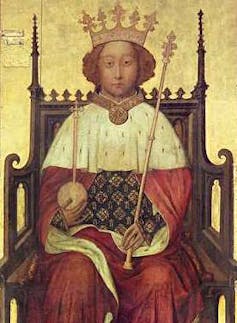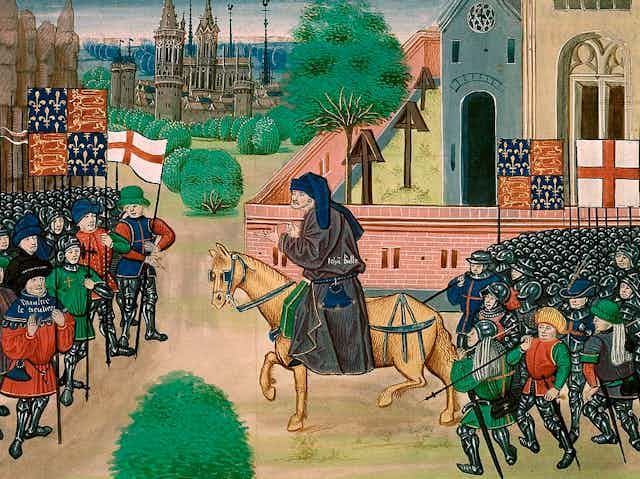As a professor of medieval Europe, I’ve taught the bubonic plague, and how it contributed to the English Peasant Revolt of 1381. Now that America is experiencing widespread unrest in the midst of its own pandemic, I see some interesting similarities to the 14th-century uprising.
The death of George Floyd has sparked protests fueled by a combination of brutal policing, a pandemic that has led to the loss of millions of jobs and centuries of racial discrimination and economic inequality.
“Where people are broke, and there doesn’t appear to be any assistance, there’s no leadership, there’s no clarity about what is going to happen, this creates the conditions for anger, rage, desperation and hopelessness,” African American studies scholar Keeanga-Yamahtta Taylor told The New York Times.
Medieval England may seem far removed from modern America. And sure, American workers aren’t tied to employers by feudal bonds, which meant that peasants were forced to work for their landowners. Yet the Peasant Revolt was also a reaction brought on by centuries of oppression of society’s lowest tiers.
And like today, the majority of wealth was held by an elite class that comprised about 1% of the population. When a deadly disease started to spread, the most vulnerable and powerless were asked the pick up the most slack, while continuing to face economic hardship. The country’s leaders refused to listen.
Eventually, the peasants decided to fight back.
Clamoring for higher wages
Surviving letters and treatises express feelings of fear, grief and loss; the death tolls from the 14th-century plague were catastrophic, and it’s estimated that between one-third to one-half of the European population died during the its first outbreak.
The massive loss of life created an immense labor shortage. Records from England describe untilled fields, vacant villages and untended livestock roaming an empty countryside.
The English laborers who survived understood their newfound value and began to press for higher wages. Some peasants even began to seek more lucrative employment by leaving feudal tenancy, meaning the peasants felt free to leave the employment of their landowning overlords.
Rather than accede to the demands, King Edward III did just the opposite: In 1349, he froze wages at pre-plague levels and imprisoned any reaper, mower or other workman in service to an estate who left his employment without cause. These ordinances ensured that elite landowners would retain their wealth.
Edward III enacted successive laws intended to ensure laborers wouldn’t increase their earning power. As England weathered subsequent outbreaks of the plague, and as labor shortages continued, workers started to clamor for change.
Enough is enough
The nominal reason for the Peasant Revolt was the announcement of a third poll tax in 15 years. Because poll taxes are a flat tax levied on every individual, they affect the poor far more than the wealthy. But similar to the protests that have erupted in the wake of Floyd’s death, the Peasant Revolt was really the result of dashed expectations and class tensions that had been simmering for more than 30 years.
Things finally came to a head in June 1381, when, by medieval estimates, 30,000 rural laborers stormed into London demanding to see the king. The cohort was led by a former yeoman soldier named Wat Tyler and an itinerant, radical preacher named John Ball.
Ball was sympathetic to the Lollards, a Christian sect deemed heretical by Rome. The Lollards believed in the dissolution of the sacraments and for the Bible to be translated into English from Latin, which would make the sacred text equally accessible to everyone, diminishing the interpretive role of the clergy. Ball wanted to take things even further and apply the ideas of the Lollards to all of English society. In short, Ball called for a complete overturn of the class system. He preached that since all of humanity constituted the children of Adam and Eve, the nobility could not prove they were of higher status than the peasants who worked for them.
With the help of sympathetic laborers in London, the peasants gained entry to the city and attacked and set fire to the Palace of Savoy, which belonged to the Duke of Lancaster. Next they stormed the Tower of London, where they killed several prominent clerics, including the archbishop of Canterbury.
A bait and switch
To quell the violence, Edward’s successor, the 14-year-old Richard II, met the irate peasants just outside of London. He presented them a sealed charter declaring that all men and their heirs would be “of free condition,” which meant that the feudal bonds that held them in service to landowners would be lifted.

While the rebels were initially satisfied with this charter, things didn’t end well for them. When the group met with Richard the next day, whether by mistake or intent, Wat Tyler was killed by one of Richard’s men, John Standish. The rest of the peasants dispersed or fled, depending on the report of the medieval chronicler.
For the authorities, this was their chance to pounce. They sent judges into the countryside of Kent to find, punish and, in some cases, execute those who were found guilty of leading the uprising. They apprehended John Ball and he was drawn and quartered. On Sept. 29, 1381, Richard II and Parliament declared the charter freeing the peasants of their feudal tenancy null and void. The vast wealth gap between the lowest and highest tiers of society remained.
American low-wage laborers obviously have rights and freedoms that medieval peasants lacked. However, these workers are often tied to their jobs because they cannot afford even a brief loss of income.
The meager benefits some essential workers gained during the pandemic are already being stripped away. Amazon recently ended the additional US$2 per hour in hazard pay it had been paying workers and announced plans to fire workers who don’t return to work for fear of contracting COVID-19. Meanwhile, between mid-March and mid-May, Amazon CEO Jeff Bezos added $34.6 billion dollars to his wealth.
It appears that the economic disparities of 21st-century capitalism – where the richest 1% now own more than half of the world’s wealth – are beginning to resemble those of 14th-century Europe.
When income inequalities become so jarring, and when these inequalities are based in long-term oppression, perhaps the sort of unrest we’re seeing on the streets in 2020 is inevitable.
[You need to understand the coronavirus pandemic, and we can help. Read The Conversation’s newsletter.]

